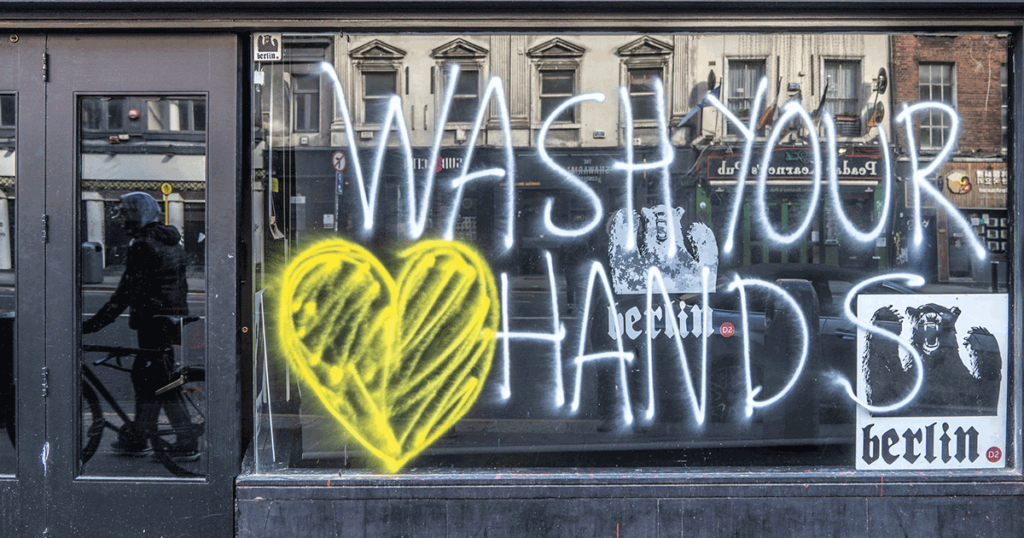
A friend tells me, by text of course, that she has just watched Todd Haynes’s movie Safe. It’s the perfect film for the Coronavirus Era, it occurs to me. In it, the world is sickening Julianne Moore, who plays Carol White. She seeks safety in the form of ever-more-scrupulous hygiene, and ends up perfectly, hygienically alone. In these times when both susceptibility and isolation are on everyone’s lips, the Carol White character is a reminder of an unbreakable historical dialectic: safety and human connection.
We live with this tension continuously in a risk-conscious world. It’s arguably why we need, and follow, cultural standards and rules: the drive to be with other people must be balanced constantly against disgust at other people (Freud’s observation). Or, more to the contemporary point, balanced constantly against the awareness that closeness to others brings danger—in the form of germs, toxins, or bad habits. Sticking to one position on the dialectical scale, hygiene-to-connectedness, is impossible. We slide along it every day, as part of the ordeal of civic life.
Coronavirus highlights the dilemma. The pain of quarantine or self-isolation goes beyond boredom and the missing of human touch: the normal human dilemma about how much to touch, and whom, has been taken out of the hands of those in isolation. And to not have to deal with the vexing question of safety and connectedness is to be slightly less human.
Carol White’s world is killing her (she has multiple chemical sensitivity and is therefore allergic, in a sense, to the entire environment). In the coronavirus era, it’s easy to feel like she does: confused, frantic, in need of psychotherapy, and perhaps even content to be utterly alone. Easy, as well, to crave direction from the authorities. Six feet apart. No unnecessary shopping. No hugs.
But remember that even the authorities are guessing. Nobody under the age of 101 has ever seen a world like ours today. Wars, sure. Local outbreaks, even fearsome ones like Ebola, yes. Disasters also: September 11th, Hurricane Katrina, earthquakes, Syria. But nobody has seen a global outbreak accompanied by so much death, and fear of death, and anxiety about how, with the stakes so seemingly high, to negotiate the hygiene-connectedness dialectic.
In a sense, then, we know both too much and not enough. The case counts, the death toll, the continuously updated and essentially useless maps showing where things are worst. But not: Will I live? Will the world look the same when this is over? How long until I can visit my parents, my children, or my friends?
One other reason to be aware that even authoritative-sounding assertions are guesswork: in a world framed by the image, the new coronavirus outbreak cannot be envisaged. It has the plot of no known movie. Not the PBS programs on the 1918 flu, not the movie Contagion. Perhaps only Murnau’s original Nosferatu comes close, the world re-rendered in German Expressionist form, the celluloid itself disfigured as the vampire is disfigured, and death—the only certainty—beckoning in the background.
Therapists say that every person who comes to see them now speaks of coronavirus and anxiety. The web is filled with advice about overcoming coronavirus anxiety. Therefore, with coronavirus the very world has tilted. It can feel like you’re about to slide off. And this is another reason why the pronouncements of officials take on so much weight. We crave the normal furnishings of everyday crisis, as if it were just an unexpected snowstorm. A desire to hear from people with titles who seem to know what needs to be done, even if they don’t know—even if they can’t know because the situation changes too quickly and too often dreadfully. Tell us there will be masks, ventilators, specialized hospitals just for COVID-19 patients. Tell us there will be doctors and nurses, there will be a medication that prevents death in the sickest—just tell us where we can get tested. The official assertion feels like a toehold on the suddenly slippery surface of the new world. But the assertion, comforting though it might be, is always somehow tangential to basic human needs. Nobody seems able truly to address the painful dialectics of safety and isolation.
Another dialectic, or tradeoff, must be faced, although it’s painful. The opportunity to save American lives was available to our national leaders in January, but nothing was done. Now, the country is in a position of deciding what people will die from. We can lower the direct death toll from coronavirus, but only by “flattening the curve.” The flattened curve is a longer curve, though. In the many months it will take to get through the outbreak under the present “mitigation” conditions, more people will die of want and its consequences, loneliness and its consequences, or domestic abuse and its consequences. And that’s assuming that the hospital crisis already under way can be managed, so that there aren’t additional deaths of people who need other kinds of hospital care but can’t get it in the coronavirus-overwhelmed hospitals. Such a decision is impossible to make. Instead, it will be made for us, made by the decision to not grapple with it. Please think about the costs of avoiding costs.
I offer no advice here. My point is that the discussion of the world in the coronavirus era must include the fact that there is no way out that is both simple and humane. If your leaders talk about bailing out big business, enforcing lockdowns with army troops, issuing a thousand-dollar check for each household, making a malaria drug available, or even declaring martial law, as if it will solve a problem—remember that they are doing something because they must do something, but that it will not be magic and it will not be salvation. The choices aren’t simple. And, in terms of lives, and the deepest needs of a human life, the choices are never cost-free.

